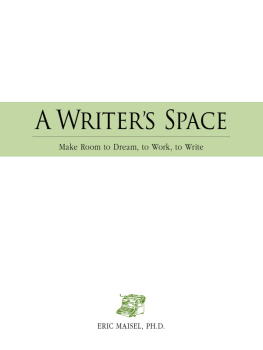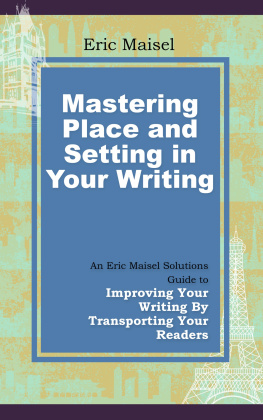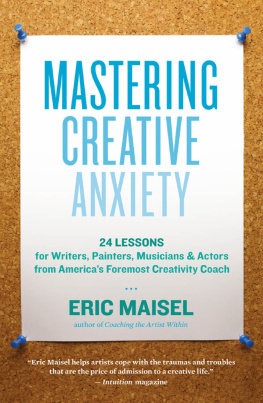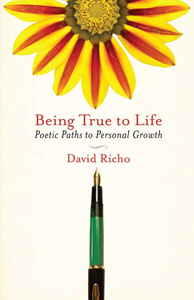Eric Maisel - A Writers Space: Make room to dream, to work, to write
Here you can read online Eric Maisel - A Writers Space: Make room to dream, to work, to write full text of the book (entire story) in english for free. Download pdf and epub, get meaning, cover and reviews about this ebook. year: 2008, publisher: Adams Media, genre: Romance novel. Description of the work, (preface) as well as reviews are available. Best literature library LitArk.com created for fans of good reading and offers a wide selection of genres:
Romance novel
Science fiction
Adventure
Detective
Science
History
Home and family
Prose
Art
Politics
Computer
Non-fiction
Religion
Business
Children
Humor
Choose a favorite category and find really read worthwhile books. Enjoy immersion in the world of imagination, feel the emotions of the characters or learn something new for yourself, make an fascinating discovery.
- Book:A Writers Space: Make room to dream, to work, to write
- Author:
- Publisher:Adams Media
- Genre:
- Year:2008
- Rating:5 / 5
- Favourites:Add to favourites
- Your mark:
- 100
- 1
- 2
- 3
- 4
- 5
A Writers Space: Make room to dream, to work, to write: summary, description and annotation
We offer to read an annotation, description, summary or preface (depends on what the author of the book "A Writers Space: Make room to dream, to work, to write" wrote himself). If you haven't found the necessary information about the book — write in the comments, we will try to find it.
Eric Maisel: author's other books
Who wrote A Writers Space: Make room to dream, to work, to write? Find out the surname, the name of the author of the book and a list of all author's works by series.
A Writers Space: Make room to dream, to work, to write — read online for free the complete book (whole text) full work
Below is the text of the book, divided by pages. System saving the place of the last page read, allows you to conveniently read the book "A Writers Space: Make room to dream, to work, to write" online for free, without having to search again every time where you left off. Put a bookmark, and you can go to the page where you finished reading at any time.
Font size:
Interval:
Bookmark:
A WRITERS SPACE
Make Room to Dream, to Work, to Write
ERIC MAISEL, PH.D.

Copyright 2008 by Eric Maisel, Ph.D.
All rights reserved.
This book, or parts thereof, may not be reproduced in any
form without permission from the publisher; exceptions are
made for brief excerpts used in published reviews.
Published by
Adams Media, an F+W Publications Company
57 Littlefield Street, Avon, MA 02322. U.S.A.
www.adamsmedia.com
ISBN-10: 1-59869-460-X
ISBN-13: 978-1-59869-460-4
eISBN: 978-1-44051-478-4
Printed in the United States of America.
J I H G F E D C B A
Library of Congress Cataloging-in-Publication Data
is available from the publisher.
This publication is designed to provide accurate and authoritative information with regard to the subject matter covered. It is sold with the understanding that the publisher is not engaged in rendering legal, accounting, or other professional advice. If legal advice or other expert assistance is required, the services of a competent professional person should be sought.
From a Declaration of Principles jointly adopted by a Committee of the American Bar Association and a Committee of Publishers and Associations
Many of the designations used by manufacturers and sellers to distinguish their product are claimed as trademarks. Where those designations appear in this book and Adams Media was aware of a trademark claim, the designations have been printed with initial capital letters.
Interior illustration by Grant Hanna.
This book is available at quantity discounts for bulk purchases.
For information, please call 1-800-289-0963.
For Ann,
Who for thirty years has provided the right space
CONTENTS
IX. EPILOGUE: CREATIVE SPACE:
A WRITING FABLE
PART I
Physical Space

CHAPTER 1
Thinking about Your Writing Space
O ther books for writers will tell you where to insert the commas and why your Parisian character shouldnt wear a beret unless hes Basque. I want to chat with you about some other things: how to get into the right space to write, how to orient and organize your neurons, how to sanctify and enliven your physical space, and how to create imagined spaces in which magic can happen.
In the thirty-six chapters that compose this book Ill use the metaphor of space to communicate how you can get a grip on your writing life and transform yourself from an occasional writer to a regular writer. My job, as I see it, is to cheerlead, to whip you into a frenzy, and once in a while to make you smile. Naturally, you will have to do the actual work.
Lets begin with your physical space, the place where you write. Should your desk face the door? Should it face the wall? What if your right shoulder faces the door and your desk is slightly to the north of the rooms only window? Should you keep books in your room or are they in league with the devil? Should your computer be stripped of its e-mail capabilities and of any software that can produce a game of solitaire? Should you wear pajamas or a business suit? Should you keep a second office in one of those urban writing centers (some with a two-year waiting list) where you go to really write? Should your walls be Navajo white, cream-colored, or Chinese red? Should your chair swivel? Should your head?
Are these the right questions?
Think of a hospital operating room. You wouldnt want your surgeon distracted by the view, would you? If that operating room overlooked the ocean, you would hope that someone would have the good sense to pull the curtains, so as to prevent glare and a roving eye. Amy Tan, for instance, explained that she writes in a very womblike place. She has two offices, one in New York and one in San Francisco. The one in New York is a former closet with low ceilings and her office in San Francisco has a window she keeps covered with drapes to block out the view. I cannot deal with distractions, she confessed. I had a beautiful office with views of the Golden Gate Bridge and the Bay but my assistant, Ellen, has that office now.
Like a surgeon, your goal is to focus. You want to muster your resources and canalize your energy. As a general rule a large space dissipates energy, noise produces distraction, views rob the mind of neurons, toys cry out to be played with, and even a book near at hand is a reason to stop early. Of course you are permitted messes, piles of papers, shelves of books, iconic snow globes and photographs, and a view of the garden. However, your goal is to canalize your energy and have your brain connect to your fingers in such a seamless way that words appear on your computer screen by magic. For this to happen, your best bet is simplicity: a little quiet, a little organization, and a little reverence.
Maybe church is a better analogy than an operating room.
You will do better work with a quiet room, a closed door, a serene view or no view at all, a little organization (and all the mess you like), and that feeling in your heart that you are in the only church you need, the one where you pray poems and praise prose. What does a church need? Does it really need all that Gothic grandiosity or ornate rococo cake decoration? Or does it need just a bench, silence, and a little awe? That is all your writing space needs: a chair, a table, silence, and a little awe. Add anything else you like, if it serves you; but dont forget this simple ideal.
You also want the kind of organization that allows you to move as fluidly as you can from idea to idea, from chapter to chapter, from file to file, from story to story, from heartbeat to heartbeat. An extreme example of this organizational nicety was Isaac Asimovs. He attributed the fact that he was able to write 500 books during his career to the way he set up his officewith tables all around the perimeter, each with several typewriters on it. Each typewriter stood ready for a different project and he would just work my way around the room. You need not go this far, but you do need to know where to reach when you are looking for Chapter 3 or those notes for that essay on Byzantium.
Everythingthe wallpaper, the cobwebs, the size of your fontis for the sake of your current project. You want to be reminded of and enveloped by that rich, new project, not by some past disaster (or success) or some future vibration. Alice Hoffman, for instance, paints her office a different color every time she starts a new book, one that resonates with the books themes, and sets out items that remind her of that book. You are a serially monogamous writer, in love with this precious new thing: let your space show it.
That great Greenwich Village character Joe Gould, portrayed in a famous Alice Neel painting with three penises, wrote seven million words in his crazy career as an oral historian and street person. He accomplished this prodigious feat without ever having a home writing space or even a home. He wrote on park benches, under awnings during rainstorms, sitting on the curb, and, of course, in cafs, where sometimes he was hired by the caf proprietor at the cost of a cup of coffee and a pastry to write and look Bohemian. Unfortunately, they were seven million words of psychotic ramblings. Might he have done better work with a quiet room of his own (and some mental health)? I think so.
You want a quiet room (and some mental health). You may also write in airports, in Paris, on top of a mountain, at the laundry, and with Beethoven blaring. You will of course want to write whenever it strikes you to write, wherever you happen to be, and whether you have your best pen with you or only your purple lipstick. But let us agree on this basic proposition: chair, table, closed door, a computer or a pad, a little awe, a little love, maybe the shades drawn, and your brain humming. That is your physical space, and your church service.
Next pageFont size:
Interval:
Bookmark:
Similar books «A Writers Space: Make room to dream, to work, to write»
Look at similar books to A Writers Space: Make room to dream, to work, to write. We have selected literature similar in name and meaning in the hope of providing readers with more options to find new, interesting, not yet read works.
Discussion, reviews of the book A Writers Space: Make room to dream, to work, to write and just readers' own opinions. Leave your comments, write what you think about the work, its meaning or the main characters. Specify what exactly you liked and what you didn't like, and why you think so.
















